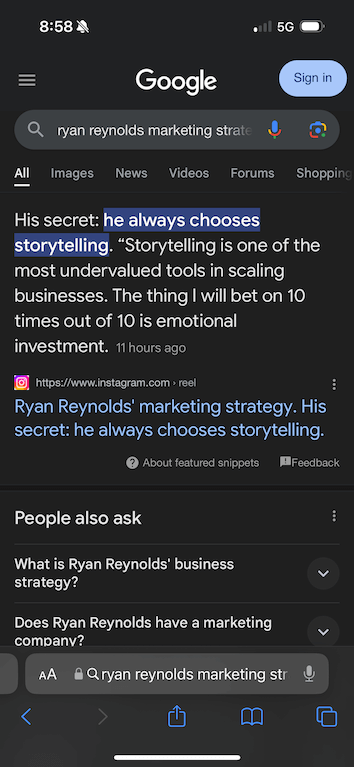Much of my audience found me through my short-form mobile videos, lots of which focus on SEO.
But what if I told you short-form video is also the fastest and easiest way to rank on Google?
Well, that’s what I tested this week.
The theory is that Google is turbocharging UGC (user-generated content) in its results.
This is because people trust blogs less, mainly due to there being so much AI-generated misinformation. Forums and UGC have become more trusted.
Most SEOs only discuss written UGC because they are too afraid or unwilling to learn how to create engaging short-form video content.
But this is actually often preferred by searchers.
A several-second video:
- Is more engaging than a written result.
- Takes less time to understand than a written result.
- Has comments so that:
- The author can be challenged.
- More details can be shared by the commenters.
The comments are key. Most articles lack commenters, which makes it harder for readers to get extra information or sources of truth.
UGC platforms all have comments.
And video is easy to consume.
Something I noticed
I noticed many of my videos ranking on Google for 2-3 word keywords.
Google was pulling my videos from TikTok, Instagram Reels, and YouTube Shorts.
It was typically only pulling videos that had decent engagement.
So here's what I tried
The day after my observation, I made a post about link echoes. I wanted to rank for ‘link echoes seo.’
It was late. I spent an hour total shooting, editing, and uploading my video.
In the first sentence of my video description, I wrote, “Link Echoes, aka Link Ghosts – the positive SEO effects of backlinks remain forever.”
The results
The video was engaging enough:
- 18,200 views on Instagram Reels and 7 comments.
- 4,441 views on YouTube Shorts and 3 comments.
- 1,600 views on TikTok and 0 comments.
24 hours after posting the video, it was ranking #1 on Google for “link echoes seo.”
Initial test successful.
Test 2
I went to the Forbes Iconoclast Summit on Thursday. Around 150 guests and over 20 trillion dollars in assets under management at this event.
Ryan Reynolds was the last speaker to go on.
I had a seat up front and made a video about what he talked about: his marketing.
I put “Ryan Reynolds Marketing Strategy” at the beginning of the description for my video.
I went to sleep.
The next morning my video was literally ranking #1 on Google for “Ryan Reynolds Marketing Strategy.”

White hat
I’m going to test more, but if this theory is true, this will be a white hat way to quickly rank for keywords.
Why white hat? Because if your video isn’t good enough to get engagement, it won’t rank.
Theoretically, you can make an engaging video and put your keyword in the opening sentence, and this will work for a short while, but it’s pointless. Where do you put the CTA for your brand? Not in the rest of the description. Not in the content of the unrelated video without reducing its quality.
Can this be exploited? No. If somebody uses an engaging video to rank for an irrelevant keyword, the searchers will bounce, and the video will be deranked. And if this happens too often for a social media account, that account’s posts will stop being shown in the search results.
So it’s hard to do this in an against-the-rules way.
Like I said I’m going to continue running tests.
But this is promising so far.
Why this is amazing
Let me put this in perspective real fast.
A normal SEO might spend days, weeks, or even months making the content to rank for a keyword.
Then another days, weeks, and months waiting for said content to rank.
I spent an hour making the content. And 24 hours waiting for it to rank #1.










